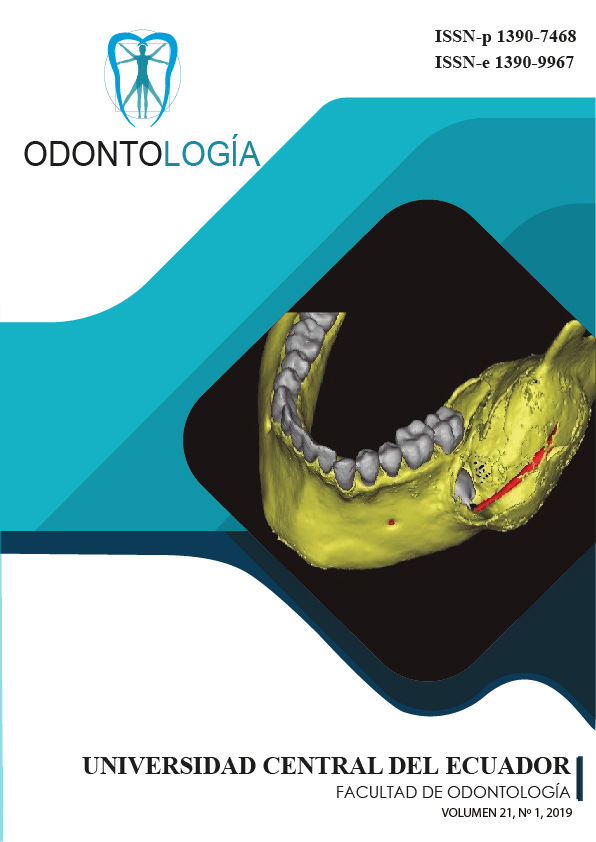Analysis of salivary cortisol and α-amylase levels in third molar surgery
DOI:
https://doi.org/10.29166/odontologia.vol21.n1.2019-44-55Keywords:
Dental anxiety, Cortisol, Psychophysiology, α-amylase, SalivaAbstract
Dental procedures involve high situation of stress and anxiety. Objectives: To verify an association of dental anxiety measured by Modified Dental Anxiety Scale (MDAS), with variations of salivary cortisol (sC) and salivary α-amylase (sAA) levels in patients undergoing third molar surgery. Materials and Methods: Thirty two patients were selected in Clínica Odontológica of Faculdade de Odontologia, Universidade de São Paulo. MDAS was accomplished in first query. Saliva samples were collected during interview, on surgery day and postoperative follow-up visits at intervals of one week at the same hour. Three patients classified as anxious, and four who reported prior traumatic event were gathered in a group. Results: There was no difference between this group and the non-anxious group when comparing gender and pain. sC levels (KW, p = 0.65) and sAA (KW, p = 0.69) on three days weren’t different in relation to gender. Levels of sAA increased in day surgery when comparing anxious/ event and non-anxious patients, while sC levels were higher during interview and postoperative follow up. Conclusion: Dental anxiety and previous dental traumatic event showed marked production of sC and sAA levels in relation to their counterparts in this situation. Subjective and objective dental anxiety relationship needs further investigations.
Downloads
References
Locker D, Liddell A, Shapiro D. Diagnostic categories of dental anxiety: a population-based study. Behav Res Ther. 1999 37: 25-37.
Nater UM, Rohleder N. Salivary alpha-amylase as a non-invasive biomarker for the sympathetic nervous system: Current state of research. Psychoneuroendocrinology .2009 34: 486-96.
Corah NL. Development of a Dental Anxiety Scale. J Dent Res 1969 48: 596.
Humphris GM, Morrison T, Lindsay SJE. The modified dental anxiety scale: validation and United Kingdom norms. Community Dent Health. 1995 12: 143-50.
Kanegane K, Penha SS, Borsatti MA, Rocha RG. Ansiedade ao tratamento odontológico em atendimento de urgência. Rev Saúde Pública. 2003 37: 786-92.
King SL, Hegadoren KM. Stress hormones: how do they measure up? Biol Res Nurs. 2002 4: 92-103.
Bakke M, Tuxen A, Thomsen CE, et al. Salivary cortisol level, salivary flow rate and masticatory muscle activity in response to acute mental stress: a comparison between aged and young women. Gerontology. 2004 50: 383-92.
Aires M M. Fisiologia 2nd ed. Rio de Janeiro: Guanabara Koogan, 1999.
Lang PJ, Davis M, Ohman A. Fear and anxiety: animal models and human cognitive psychophysiology. J Affect Disord. 2000 61: 137-59.
Shirasaki S, Fujii H, Takahashi M et al. Correlation between salivary alpha-amylase activity and pain scale in patients with chronic pain. Reg Anesth Pain Med. 2007 32: 120-3.
Castro M, Moreira AC. Análise crítica do cortisol salivar na avaliação do eixo hipotálamo-hipófise-adrenal. Arq Bras Endocrinol Metabol. 2003 47: 358-67.
Lawrence HP. Salivary markers of systemic disease: noninvasive diagnosis of disease and monitoring of general health. J Can Dent Assoc. 2002 68: 170-4.
DeCaro JA. Methodological considerations in the use of salivary alpha-amylase as a stress marker in field research. Am J Hum Bio. 2008 20: 617-9.
Granger DA, Blair C, Kivlighan KT et al. Salivary alpha-amylase in biobehavioral research: recent developments and applications. Dev Psychobiol. 2007 1098: 122-44.
Wong M, Lytle WR. A comparison of anxiety levels associated with root canal therapy and oral surgery treatment. J Endod. 1991 17: 461-5.
Fuster-Torres MA, Gargallo-Albiol J, Berini-Aytés L, Gay-Escoda C. Evaluation of the indication for surgical extraction of third molars according to the oral surgeon and the primary care dentist. Experience in the Master of Oral Surgery and Implantology at Barcelona University Dental School. Med Oral Patol Oral Cir Bucal. 2008 13: 499-504.
Cohen SM, Fiske J, Newton JT. The impact of dental anxiety on daily living. Br Dent J. 1996 189: 385-90.
Thomson WM, Locker D, Poulton R. Incidence of dental anxiety in young adults in relation to dental treatment experience. Community Dent Oral Epidemiol. 2000 28: 289-94.
Eli I, Uziel N, Blumensohn R, Baht R. Modulation of dental anxiety – the role of past experiences, psychopathologic traits and individual attachment patterns. Br Dent J. 2004; 196: 689-94.
Lazarus R S. Stress and Emotion: a new synthesis. London: Free Association Books, 1999.
Robles TF, Sharma R, Park K et al. Utility of a salivary biosensor for objective assessment of surgery- related stress. J Oral Maxillofac Surg. 2012 70: 2256-2263.
Chatterton RT Jr, Vogelsong KM, Lu YC et al. Salivary alpha-amylase as a measure of endogenous adrenergic activity. Clin Physiol. 1996 16: 433-48.
Schoofs D, Hartmann R, Wolf OT. Neuroendocrine stress responses to an oral academic examination: No strong influence of sex, repeated participation and personality traits. Stress. 2008 11: 52-61.
Cozma S, Dima-Cosma LC, Ghiciuc CM, Pasquali V, Saponaro A, Patacchioli FR. Salivary cortisol and alpha-amylase: subclinical indicators of stress as cardiometabolic risk. Braz J Med Biol Res. 2017 50(2): e5577
Tanaka Y, Ishitobi Y, Maruyama Y, et al. Salivary alpha-amylase and cortisol responsiveness following electrical stimulation stress in major depressive disorder patients. Prog Neuro-Psychopharmacol Biol Psychiatry. 2012 36: 220-4.
International Association for the Study of Pain. Introdução. Retrieved March 01, 2017, from: http://www.sbed.org.br/materias.php?cd_secao=76
Rhudy JL, Meagher MW. Fear and anxiety: divergent effects on human pain thresholds. Pain. 2000 84: 65-75.


